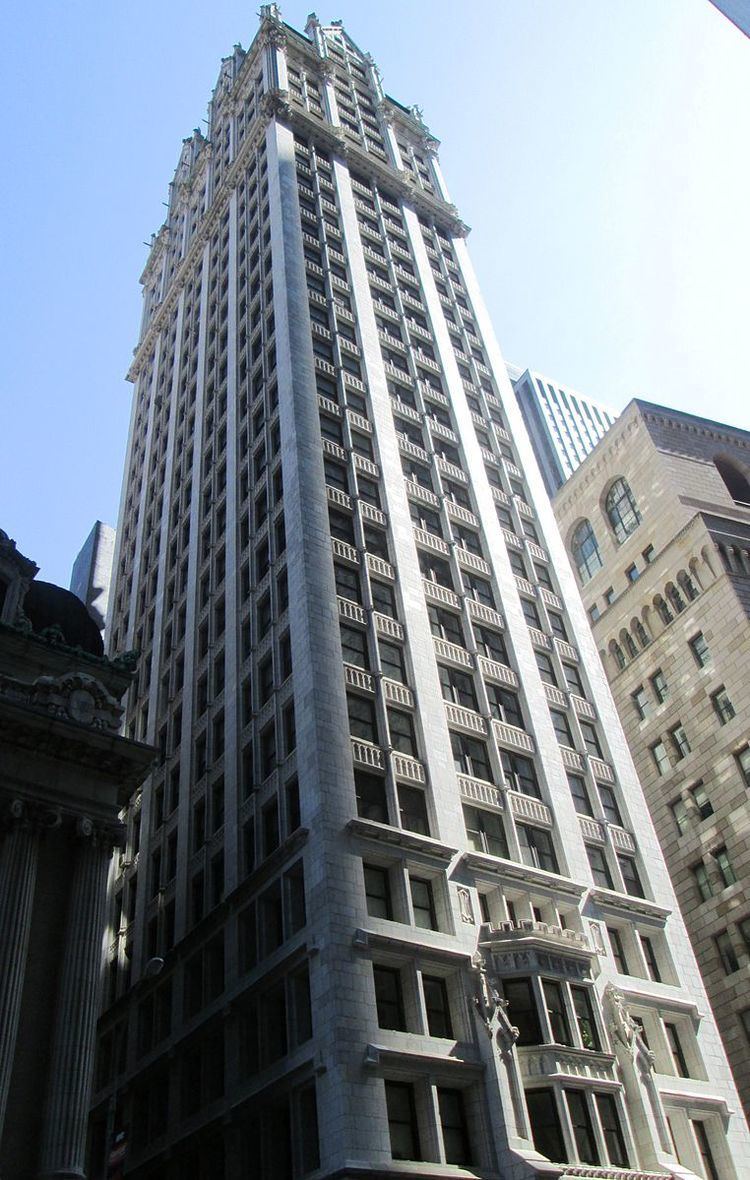Built 1909=10 NRHP Reference # 83001734 Designated NYCL August 24, 1982 Floors 33 | Added to NRHP September 15, 1983 Height 117 m Phone +1 212-964-5432 | |
 | ||
Address 55 Liberty St, New York, NY 10005, USA Similar Singer Building, City Investing Building, Equitable Building, One World Trade Center, Adams Express Building | ||
The Liberty Tower, formerly the Sinclair Oil Building, is located at 55 Liberty Street at the corner of Nassau Street in the Financial District of Manhattan, New York City was built in 1909-10 as a commercial office building and was designed by Chicago architect Henry Ives Cobb in a Gothic Revival style. It was built on a site adjacent to the New York City Chamber of Commerce Building (1901); the subsequent New York Federal Reserve Bank building was constructed to the east, across Nassau Street, in 1922. A completely free-standing 33-story building, in 1909 Liberty Tower was the tallest building in the world with such a small footprint. The limestone building is covered in white architectural terracotta ornamented with birds and alligators and other fanciful subjects.
History
Before its construction in 1909, a prior building on the same site housed the offices of the New York Evening Post under editor William Cullen Bryant, and served as the first headquarters of the American Society for the Prevention of Cruelty to Animals, established by Henry Bergh in 1867.
The building’s striking Gothic style, the centuries-old inspiration for cathedral spires that reach into the sky to approach the divine, is central to the tower’s romantic appeal.
“That America in 1909 would take this medieval idea and match it up with a skyscraper that went up 33 stories is a wonderful combination,” Mr. Lombardi said.
It was built by the Liberty-Nassau Building Company as a speculative office building, according to the Landmarks Preservation Commission. It was at first called the Bryant Building, the name of the seven-story building that had occupied the site and which served from 1853 to 1875 as home to The New York Evening Post, whose editor at the time was William Cullen Bryant.
Liberty Tower has a storied history. President Theodore Roosevelt's law office was one of its first commercial tenants after the building opened in 1910. In 1917, an office was leased as cover for German spies seeking to prevent America's intervention in World War I (then called "The Great War"). The plot involved an attempt to draw the United States into a diversionary war with Mexico and Japan. The plot was exposed on March 1, 1917, with news reports of an intercepted telegram decoded by British cryptographers, the notorious "Zimmermann Telegram", which prompted President Woodrow Wilson to declare war against Germany a month later.
Shortly afterward, the entire building was leased by the Sinclair Oil Company, responsible for the Teapot Dome scandal of 1922. Prior to the 1974 Watergate scandal, this was called "the most sensational scandal in the history of American politics," and became the most enduring legacy of Warren G. Harding's troubled presidency.
In 1979, the structure, renamed Liberty Tower, was converted from commercial use into a residential building, one of the first such conversions in Manhattan south of Canal Street, by architect Joseph Pell Lombardi. It was designated a New York City landmark in 1982, and was added to the National Register of Historic Places on September 15, 1983.
Because the then new principles of "skyscraper" design were not yet fully understood, the building was overbuilt, with its steel foundation anchored deeply into bedrock five stories below street level. This overly sturdy construction helped this tall, slender building withstand the collapse of two World Trade Towers only 220 yards to the west on September 11, 2001, with only minimal damage despite the impact which was measured at the time as a 3.3 magnitude seismic event.
Joseph Pell Lombardi, a restoration architect who converted the Liberty Tower building in 1978 and retains a floor-through apartment on the 29th floor, said that when the World Trade Center towers crashed to the ground, “the whole building shuddered. I actually was thrown against the wall, it was such an impact. These tight terra-cotta joints couldn’t take that stress.”
While the facade was already suffering from sloppy past repairs, corrosion of its steel frame and deferred maintenance, “the unusually severe seismic events of Sept. 11, 2001” appeared to have caused significant additional damage, LZA Technology, a structural engineering consulting firm hired by building management, concluded in a September 2003 report. The damage let in water, rusting the steel underneath. The steel expanded as it rusted, enlarging the cracks and threatening eventually to loosen the blocks.
In a two-year restoration lasting from 2007 to 2009, 202 exterior sculptures and about 3,200 terra-cotta blocks were replaced or restored. An additional 1,040 blocks underwent lesser repairs.
